Deutschland’s “Firenze-am-Elbe”
I knew very little about Dresden before I got there. I knew it had a beautiful opera house, demolished in the war and then rebuilt; I knew R Wagner had achieved something along the lines of normal worldly success when he lived here in the 1840s, before he went off the deep end and underwent the transformation that changed the successful, popular author of Lohengrin into the mad genius who forged Das Rheingold. And I knew that Dresden had been called Germany’s “Florence on the Elbe”—the way East Lansing, MI likes to refer to itself as “the Boston of the Midwest”. But the name is well deserved. Dresden is honestly one of the most beautiful cities I’ve ever had the good fortune to visit, even though my stay there was way too brief. I concentrated on five things:
The Frauenkirche.

Completely demolished in the war, this early 18th-century church is the heart of the city—so imagine what a great source of civic pride it was when the rebuilt church was reopened last fall. (Everywhere else you go in the city you see re-constrcution projects proceeding apace.) The church is built from Saxon sandstone found nearby (Dresden is the capitol of the state of Sächsen, Saxony, from whence came one half of the Anglo-Saxon group, who set up in England ‘East Saxon-land’ (Essex) and ‘South Saxon-land’ (Sussex) before being raped by Vikings and conquered by French Norsemen. But that’s another story, and hardly relevant here. Sorry.) It’s the tallest thing in Dresden, by law, and from the top of the dome (100 m or so) you get an amazing view of the city and the river.
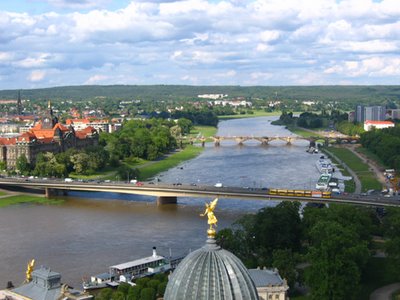
Inside the church proper, all is air, light, and pastel.

The contemplative underground crypt, where they were playing Enya while setting up for the evening’s concert, was too much for me.
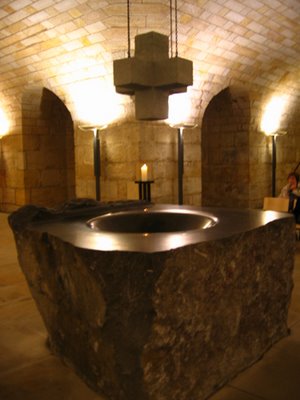
Semper Oper.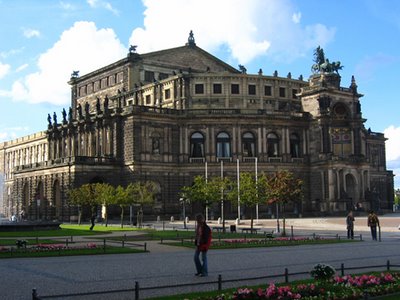 Or, “Opera Forever!” What a slogan; we had t-shirts printed last summer, for sale in our gift shop, which read “Life is Short / Opera is Long / Wagner is Forever”. The architect Gottfried Semper designed this opera house to match the nearby, Baroque, Zwinger Palace. The architectural style in which he was working was thus about a century old—and when the theater was restored, after the war, the style was more than two centuries old. No matter, it’s a dazzling building. Richard Wagner was Kappelmeister working for this company, but never in this building—it was built after he was exiled for playing a role in the Dresden uprising of 1849. (He had tried to get Semper to join the revolutionaries, too, but the architect knew better than to follow his common-sense-challenged composer friend. Later, Semper would work with Wagner to design a glorious new theater in Munich—a theater which was never built. I was also delighted to find the building where Wagner lived, right across from the Zwinger Palace, in luxury he couldn’t afford, amassing his famous Dresden library.
Or, “Opera Forever!” What a slogan; we had t-shirts printed last summer, for sale in our gift shop, which read “Life is Short / Opera is Long / Wagner is Forever”. The architect Gottfried Semper designed this opera house to match the nearby, Baroque, Zwinger Palace. The architectural style in which he was working was thus about a century old—and when the theater was restored, after the war, the style was more than two centuries old. No matter, it’s a dazzling building. Richard Wagner was Kappelmeister working for this company, but never in this building—it was built after he was exiled for playing a role in the Dresden uprising of 1849. (He had tried to get Semper to join the revolutionaries, too, but the architect knew better than to follow his common-sense-challenged composer friend. Later, Semper would work with Wagner to design a glorious new theater in Munich—a theater which was never built. I was also delighted to find the building where Wagner lived, right across from the Zwinger Palace, in luxury he couldn’t afford, amassing his famous Dresden library.
Now, when I first got to the Semper Oper, there was quite a to-do; somebody was making a film with the opera as backdrop for a shot. Seemed to be a music video or music dream-sequence of some kind, since the camera on a big dolly kept swinging down onto an old man with white hair, singing (the sync-tape was broadcast for each take) a well-known waltz the name of which is escaping me. Viennese but with a dark eastern melodic contour.
In the shot, while he sang, pairs of attractive young people swirled around him, waltzing.
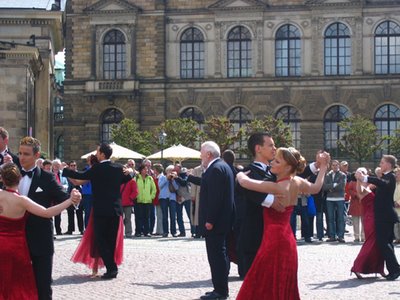
And of course a crowd of tourists (including me) had gathered to gawk. I, of course, was busily storing up ideas about how to film in Dresden for when I create my own magnificent up-and-coming Wagner bio-pic!
Zwinger Palace.
I was disappointed to find that the Dresden museum with paintings by C. D. Friedrich, one of my favorite painters, was closed for renovation (always check these things on the website first!). So I went instead to the outrageously beautiful Zwinger Palace, right next to Semper Oper, to check out the Alte Meister Gallery, their collection of Renaissance and Baroque paintings. You all know the detail of a Raphael Holy Family they have there—-these two cherubs are really staring up at Mary and the rest, and they only take up the bottom sixth of the very large painting.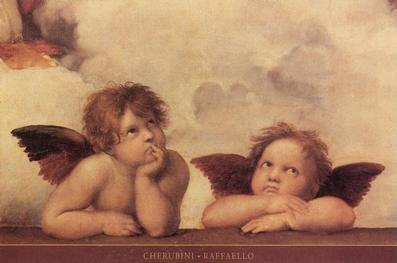
Neustadt.
I had a wonderful and memorable evening in Dresden, lying on the banks of the Elbe in the sunset like Anselmus enamoured of the three green snakes (but more on that famous story—perhaps much more—to come). Then I went up and explored Neustadt, which according to my research is where all the hip young Dresdeners live today—a neighborhood which reminded me of Capitol Hill, first Altounstraße (the Pike/Pine corridor) and then Bautzner Straße (15th). I joined the cast of my favorite SIFF film last year, The Edukators, for dinner (couldn’t tell you what we were eating, but it was cheap) at a little garden with a grill and great people-watching, in the Pike/Pine-ish area. (In case you’re wondering, hip German youth look just like hip Amerikanischer Jugend—eccentric jeans, hoodies, and all the kids these days are wearing white belts.) Then I betrayed my revolutionary acquaintances—just like Semper—and went to the charming Café Neustadt on the 15th-ish street, where two girls were playing jazz and eine hübsches Kind served me some unnecessarily strong coffee. I realized the minute I walked in that if I lived in Dresden, that place would be where I’d be found.
Graupa.
But the weirdest—and best—of my Dresden adventures was my voyage to the lame Richard Wagner museum, in the village of Graupa on the outskirts of Dresden. Wagner came to Graupa for a summer holiday in 1846, and apparently wrote much of Lohengrin out there. The museum (formerly in the house where he lived, now in a nearby school) doesn’t have anything especially exciting, except a postcard with a picture of Georg Unger, the first Siegfried in 1876, which I’d never seen.
But the trip out there! It took me an hour, by tram and bus, and would only have been marginally quicker with a car. It was great. I met an old lady from Stuttgard who had grown up in Dresden in the 50s, but who escaped before the wall was built and escape became impossible. She was returning home after many years; her daughter, it turned out, taught Japanese at the University of Washington (although she herself had never been to Seattle). Anyways, the trip went through some charming neighborhoods of Dresden I wouldn’t otherwise have seen, crossed the Elbe, and then went up the hills into wine and farm country and eventually to this adorable village, where even Richard Wagner found it possible to chill out, hunker down, and do some creating. And thank heavens he did!


0 Comments:
Post a Comment
<< Home